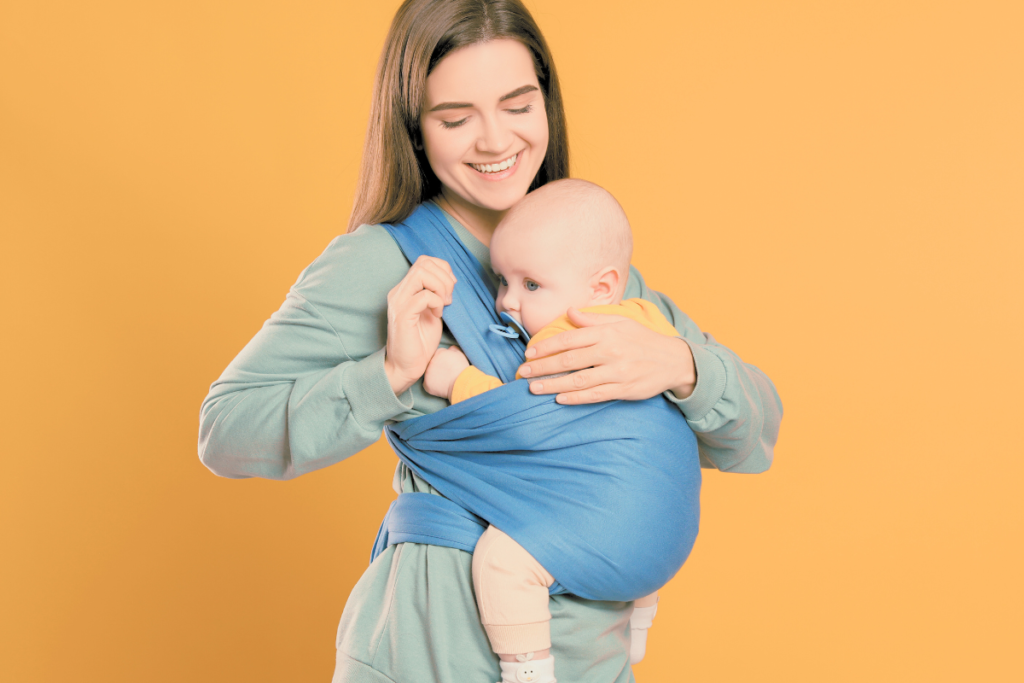Babywearing, the practice of carrying a baby in a carrier or sling, has been used for centuries across various cultures. In recent years, it’s gained renewed attention for its numerous benefits for both babies and caregivers. This guide covers the physical, emotional, and developmental advantages of babywearing, as well as tips on choosing the right carrier and mastering babywearing techniques for comfort and safety.

Benefits of Babywearing
1. Promotes Bonding and Attachment
- Babywearing fosters close physical contact, which is beneficial for bonding. The act of holding your baby close helps release oxytocin, also known as the “love hormone,” in both parent and child, strengthening emotional bonds and creating a sense of security for the baby.
- It’s especially beneficial for parents who may not get as much time to bond with their child, such as working parents or fathers who may not be able to breastfeed.
2. Supports Baby’s Physical Development
- Babywearing promotes proper hip development. When a baby is worn in a carrier that supports their hips and spine correctly, it encourages a natural “M” position (also known as the frog position), which is critical for healthy hip joint development and helps prevent hip dysplasia.
- Carriers that hold the baby upright can assist with muscle development in the neck and shoulders, as the baby exercises these areas to hold up their head and interact with the surroundings.
3. Reduces Crying and Colic
- Studies show that babies who are worn cry significantly less than those who aren’t, possibly due to the calming effects of being close to a caregiver’s heartbeat, warmth, and familiar scent.
- Babywearing also promotes digestion, as the upright position can reduce acid reflux and colic, making it easier on both baby and parent.
4. Enhances Cognitive and Emotional Development
- Being at eye level with their caregiver allows the baby to engage with the world, boosting their cognitive development. Babies observe their parents’ facial expressions, social interactions, and the environment, which can aid in language and emotional development.
- The secure environment of babywearing allows babies to feel safe while exploring their world, fostering independence and confidence as they grow.
5. Increases Convenience and Freedom for Caregivers
- Babywearing is convenient for parents, especially when they have other children or responsibilities. Wearing your baby allows you to have both hands free, which makes everyday tasks easier to handle while keeping the baby close.
- Babywearing can be a great alternative to a stroller, especially in crowded areas or when navigating stairs and public transportation.
Types of Baby Carriers and How to Choose the Right One
There are several types of baby carriers, each with its own benefits and considerations. Here’s a breakdown:
- Wraps
- Description: Wraps are long, stretchy or woven fabric pieces that wrap around the caregiver’s body and the baby.
- Best for: Newborns and young infants.
- Advantages: Offers a snug fit and is highly adjustable for comfort and a custom fit. Ideal for newborns due to the cocoon-like feel.
- Drawbacks: Can be tricky to learn to tie properly; it takes some practice to get it right.
- Ring Slings
- Description: Made of a single piece of fabric threaded through two rings, worn over one shoulder.
- Best for: Quick and easy wear, especially for newborns.
- Advantages: Quick to put on and adjust, lightweight, and breathable. Ring slings can be especially convenient for short outings.
- Drawbacks: Can strain one shoulder with prolonged use and may not be as supportive as other carriers for older, heavier babies.
- Soft-Structured Carriers (SSCs)
- Description: These carriers have padded straps and buckles, offering a more structured fit.
- Best for: Babies who can hold their heads up (around 4-6 months), but many SSCs have inserts for newborns.
- Advantages: Easy to put on and adjust, with options for front and back carrying. Provides excellent support for older babies.
- Drawbacks: Bulkier than wraps or slings and may be less comfortable for very young infants.
- Mei Tai Carriers
- Description: A blend of a wrap and SSC, these are structured with straps that tie around the caregiver’s waist and shoulders.
- Best for: Babies of all ages, from newborn to toddler.
- Advantages: Provides the custom fit of a wrap with more structure for support, allowing multiple carrying positions.
- Drawbacks: Requires tying, which may be less convenient than buckle carriers for some parents.
- Backpack-Style Carriers
- Description: Designed like hiking backpacks, these carriers are sturdy and often have additional storage pockets.
- Best for: Older babies and toddlers (typically over 6 months).
- Advantages: Offers superior support for long-duration carrying; ideal for outdoor activities and hiking.
- Drawbacks: Bulkier and more expensive; not suitable for infants.
Babywearing Techniques and Safety Tips
Once you have your preferred carrier, learning the right techniques is crucial for both comfort and safety. Here are some essential tips:
1. Follow T.I.C.K.S. Rules for Safe Babywearing
- Tight: The carrier should hold the baby snugly against you.
- In view at all times: Ensure the baby’s face is always visible.
- Close enough to kiss: The baby should be close enough that you can easily kiss their forehead.
- Keep chin off the chest: Make sure the baby’s head isn’t tilted forward so much that it obstructs breathing.
- Supported back: The baby’s back should be supported in a natural position, not slumped or arched.
2. Newborn Technique: Frog Position
- For newborns, always ensure they’re in the “M” or frog-leg position, with knees higher than their bottom and hips spread. This position supports proper hip development and keeps them comfortable.
3. Front, Hip, and Back Carry Techniques
- Front Carry: Best for newborns and infants. This position keeps the baby close and lets them observe your face, which is soothing for younger babies.
- Hip Carry: Ideal for babies who have developed strong head and neck control (around 4-6 months). It allows the baby to see more of their surroundings while still being supported.
- Back Carry: Suitable for older babies and toddlers who can sit up independently. This technique frees up the front of the caregiver’s body, which can be more comfortable during long periods.
4. Adjust for Comfort and Balance
- Ensure the baby’s weight is evenly distributed across your shoulders, hips, and back, adjusting straps or fabric to avoid strain. If you’re using a wrap or sling, practice getting the tension right so that it feels secure but not restrictive.
5. Stay Alert to Baby’s Needs
- Monitor the baby for signs of discomfort, overheating, or restriction. Babies can overheat quickly, so dress them appropriately for the season, paying attention to the additional warmth from your body heat.
Conclusion
Babywearing is a wonderful way to keep your baby close, strengthen your bond, and support their development. It can also be a practical solution for parents balancing multiple responsibilities. Choosing the right carrier, learning safe techniques, and adjusting as your baby grows will ensure that both you and your little one enjoy a comfortable and fulfilling babywearing experience.
